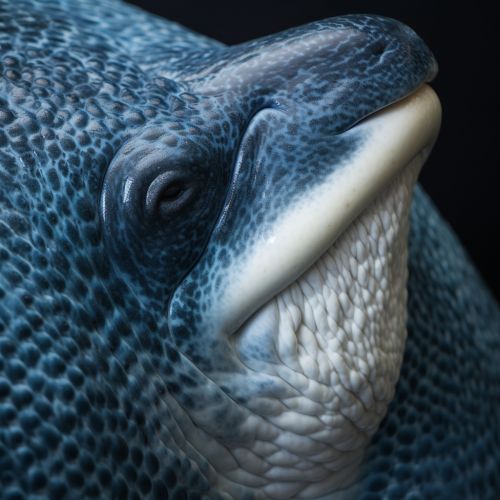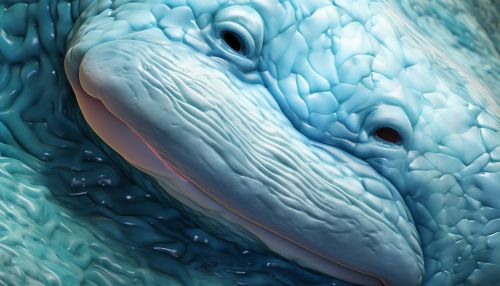Blubber
Overview
Blubber is a thick layer of vascularized adipose tissue found under the skin of all cetaceans, pinnipeds and sirenians. Its primary function is to store energy in the form of fat although it also serves as an effective form of insulation for these marine mammals. The presence of blubber in marine mammals is a crucial adaptation that allows them to survive in extreme cold environments.


Anatomy and Composition
Blubber is more than simply fat; it is a complex, multi-functional organ that plays a critical role in the biology of marine mammals. It is composed of lipids and is highly vascularized, with a rich blood supply that helps distribute heat throughout the body. The lipid composition of blubber varies between species, and even between individuals of the same species, depending on factors such as diet, age, sex, and health status.
Lipid Composition
The lipids in blubber are primarily triglycerides, stored in large, specialized adipocytes. These triglycerides can be metabolized to produce energy as needed. In addition to triglycerides, blubber also contains significant amounts of wax esters, particularly in deep-diving species such as sperm whales and beaked whales. These wax esters may serve as an additional energy source, and may also play a role in buoyancy control.
Vascularization
The high degree of vascularization in blubber is key to its role in thermoregulation. The blood vessels in blubber help distribute heat throughout the body, preventing hypothermia in cold water. When a marine mammal is in warm water or air, the blood vessels in the blubber can constrict, reducing blood flow and helping the animal avoid overheating.
Functions
Blubber serves several vital functions in marine mammals. These include energy storage, insulation, buoyancy control, and protection from predators.
Energy Storage
Blubber is a critical energy reserve for marine mammals. During times of plenty, these animals can build up their blubber layer by consuming large quantities of food. Then, during lean times or periods of fasting associated with migration, reproduction, or molting, they can metabolize the fat in their blubber to sustain themselves.
Insulation
Blubber is an effective insulator, helping marine mammals maintain their body temperature in cold water. The insulating properties of blubber are due to its thickness and the low thermal conductivity of fat. This insulation is so effective that some marine mammals can maintain a core body temperature of 37°C even in freezing water.
Buoyancy Control
Blubber also contributes to buoyancy control in marine mammals. The fat in blubber is less dense than water, which helps these animals stay afloat. In addition, the wax esters in blubber may play a role in fine-tuning buoyancy, particularly in deep-diving species.
Protection
Finally, blubber serves as a form of protection for marine mammals. The thick layer of fat can help shield these animals from injury, and may also deter predators by making the animals appear larger and more formidable.
Blubber in Different Species
The thickness and composition of blubber can vary widely between species, and even between individuals of the same species. These differences reflect variations in diet, habitat, and lifestyle.
For example, polar bears, which live in the Arctic and feed primarily on seals, have a very thick blubber layer. This blubber not only provides insulation in the freezing Arctic waters, but also serves as a crucial energy reserve during the long Arctic winter, when food is scarce.
In contrast, dolphins, which live in warmer waters and have a more varied diet, have a thinner blubber layer. However, this blubber is still critical for energy storage, insulation, and buoyancy control.
Human Uses of Blubber
Humans have utilized blubber for thousands of years. In many traditional cultures, blubber was a valuable food source, providing a concentrated source of energy and essential fatty acids. Blubber was also rendered into oil, which was used for lighting, heating, and cooking.
Today, the commercial exploitation of marine mammals for their blubber is largely prohibited by international law. However, some indigenous communities are still allowed to hunt marine mammals for subsistence, and blubber continues to be an important part of their diet and culture.
Conservation Issues
The health of a marine mammal's blubber layer can be an indicator of the overall health of the individual and the population. Changes in blubber thickness or composition can reflect changes in diet, habitat, or stress levels, and can be a sign of broader environmental changes.
In recent years, there has been growing concern about the accumulation of pollutants in blubber. Many pollutants, including heavy metals and persistent organic pollutants, are lipophilic, meaning they dissolve in fat. These pollutants can accumulate in the blubber of marine mammals, with potential impacts on their health and reproduction.
